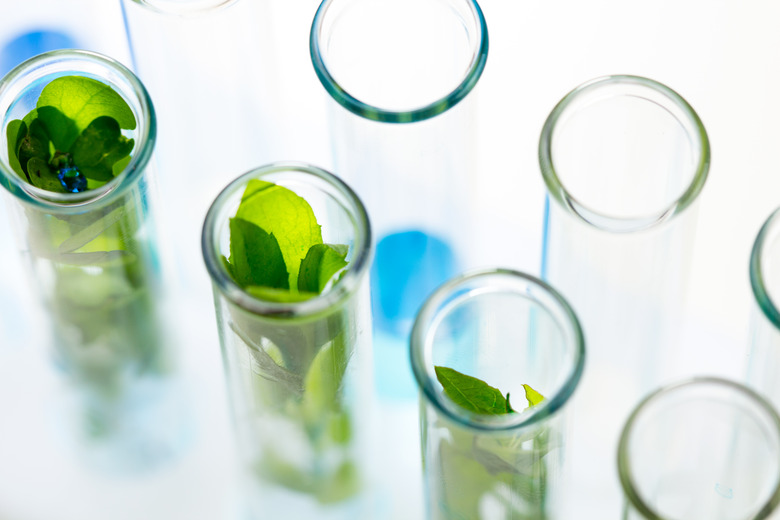Difference Between Heterotrophs & Autotrophs
Autotrophs and heterotrophs are two important categories of living organisms on Earth. Autotrophs are those organisms that are able to extract raw carbon from the atmosphere and turn it into energy-rich compounds, producing their own fuel; by contrast, heterotrophs are those organisms that cannot produce their own carbon-based food and must obtain it by consuming other materials — very frequently, the same ones produced by the autotrophs.
The relationships of consumption and production between autotrophs and heterotrophs compose the food chains (or more accurately food webs) that drive ecosystems all around the world.
TL;DR (Too Long; Didn't Read)
Autotrophs, such as plants, produce their own food. Heterotrophs, such as humans, eat foods produced by other organisms.
What are Autotrophs?
What are Autotrophs?
Autotrophic organisms are called "producers" because they create their own food; the word "autotrophic" in Greek means "self-feeding." A small number of bacteria, including the ancient Archaea group, are capable of generating food from sulfur or other chemical reactions, but the majority of autotrophs rely on sunlight. As a result, they are known as "phototrophs" or "photoautotroph," a group that includes the other autotrophic bacteria as well as plants.
All of these autotrophs are primary producers, meaning they take energy and materials to create the most basic levels of resources and energy in an ecosystem.
TL;DR (Too Long; Didn't Read)
Bacteria that create food and material through chemical reactions instead of light energy use a process called chemosynthesis. They are sometimes also called chemoautotrophs because they use chemical energy to sustain themselves.
Autotrophs and Photosynthesis
Autotrophs and Photosynthesis
One of the most common autotrophic processes, "photosynthesis," uses specialized molecules to capture carbon from the air and bind it with water using energy produced from sunlight. Following the standard scientific terminology that molecules using water are known as "hydrates," the resulting carbon compound is known as a "carbohydrate." Because it removes free-floating atmospheric carbon and converts it into solid form, this photosynthetic process is known as "carbon fixation." The ability to fix carbon is the primary difference between autotrophs and heterotrophs.
Plants and other autotrophs utilize a complex series of interconnected processes to take in carbon dioxide from the atmosphere, solar energy, and water to create glucose and oxygen. The plants then use these products to support their own growth.
Some examples of autotrophs include phytoplankton, algae, trees, and many other plants and bacteria. They are the key component in turning inorganic substances into a mode of nutrition and source of energy for world ecosystems.
TL;DR (Too Long; Didn't Read)
Green plants are some of the most recognizable autotrophs on the planet. They are green because of a pigment called chlorophyll that helps to absorb more sunlight. Plant cells also have a specialized organelle called a chloroplast to perform photosynthesis.
What are Heterotrophs?
What are Heterotrophs?
Most types of life, including most bacteria, cannot fix carbon and must obtain their energy by consuming either organic compounds produced by autotrophs or by relying on sulfur or hydrogen reduction. There are many examples of heterotrophs across different trophic levels and ecosystems. Animals, including people, are heterotrophs, along with fungi and most single-celled organisms that do not possess a cell nucleus. Many autotrophs are capable of consuming the carbohydrates produced by autotrophs, and are therefore part of a larger carbon cycle that encompasses most forms of life.
The relationship between heterotrophs and autotrophs breaks down into a sequence of energy and consumption. There are many types of heterotrophs, but in a common system, plants create carbon matter and energy from the resources around them. Herbivores then eat these plants, extracting energy from their stored carbon and glucose. Carnivores then eat herbivores or other carnivores, instead of plant matter, and omnivores are capable of eating plants and animals. Decomposers (like fungi, bacteria, and small organisms) continue the cycle by breaking down matter from carnivores and herbivores into organic matter that plants can use to support photosynthesis.
The process by which heterotrophs harness energy and heterotrophic nutrition is cellular respiration which takes in organic carbon, organic molecules, water, and oxygen to create energy for their system.
TL;DR (Too Long; Didn't Read)
Energy in cellular respiration and photosynthesis is often moved around in the form of molecules called ATP. Proteins, other organic molecules, and enzymes are used throughout these processes as well.
In the Middle
In the Middle
Not all organisms fit neatly into a division between heterotroph and autotroph. If an organism must produce its own carbon compounds rather than consuming those produced by others, it is known as "obligate" autotroph. Some bacteria and other microorganisms, though, can either obtain carbon from autotrophic activity or rely on other organic material for it. These organisms have more complex scientific names based on the exact nature of their energy production but fall into the general category of "mixotrophs," combining heterotrophic and autotrophic activity.
Some organisms might still perform photosynthesis or chemosynthesis to produce energy and carbon, but they can not rely on carbon dioxide as their only carbon source. They are often called photoheterotrophs or chemoheterotrophs. Practically they still use autotrophic nutrition, and they may get supplemental carbon from organic or inorganic sources, but there is still a distinction from classic autotrophs.
Cite This Article
MLA
Allen, Robert. "Difference Between Heterotrophs & Autotrophs" sciencing.com, https://www.sciencing.com/difference-between-heterotrophs-autotrophs-8274633/. 11 July 2023.
APA
Allen, Robert. (2023, July 11). Difference Between Heterotrophs & Autotrophs. sciencing.com. Retrieved from https://www.sciencing.com/difference-between-heterotrophs-autotrophs-8274633/
Chicago
Allen, Robert. Difference Between Heterotrophs & Autotrophs last modified July 11, 2023. https://www.sciencing.com/difference-between-heterotrophs-autotrophs-8274633/
